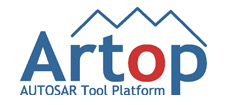Artop 4 Eclipse

As most of our tech-savvy readers will know, a modern car is actually a complex network of around one hundred computers on wheels. And in the future, that network will itself be a node on wheels in an even more complex network of other cars and further road-side and backbone nodes - all of those nodes being implemented by different companies. It is obvious, that automotive companies need comprehensive software engineering know-how.
A bit of history
Flashback to the year 2003. Major players in the automotive industry recognized that they were facing serious challenges in software engineering. At that time, the software that runs in the electronic control units (ECU) in the car was often very tightly coupled to the hardware and the specific implementation of the basic software (the operating system of an ECU). It was often really hard to separate the actual control software from the basic software. And even then, there was no real standard for the basic software (BSW), reducing portability even further.
So major players got together and founded the AUTOSAR partnership to provide a common standard to address these problems. In more than 10 years of its existence, AUTOSAR provided a software engineering standard for the automotive domain, that standardizes three major fields: The basic software that runs the ECUs, resulting in a definition of a common "operating system", an exchange format that standardizes the description of software engineering artefacts to facilitate cross-company exchange and standardized functional interfaces.
In the beginning, a lot of the business cased argumentation focused on the standardization of the BSW, but the tooling departments and companies recognized the importance of the common exchange model. After some isolated experiments, the first companies got together in 2008 to form the "Artop (AUTOSAR tool platform)" community. While AUTOSAR was based on "Cooperate on standards, compete on implementation", the Open Source idea was already more established on the tooling side and it was recognized that a common implementation of the exchange format would be the most feasible approach and that Eclipse EMF provides a very good basis for automotive tooling.
What is Artop?
Today, the Artop community is providing a common implementation of the complex AUTOSAR-metamodel, which supports all kind of artefacts like software architecture, network definitions, hardware configurations and even feature-modelling and variant specifications. On top of plain EMF, AUTOSAR has defined some intricate concepts, such as splitting a model element over several files which are also supported by Artop.
Artop is now being used as the basic platform for a number of commercial as well as in-house tools and is a perfect basis for tool integrations. Without Artop, the introduction of AUTOSAR tooling would have come with a much higher cost for many companies.
Although the Artop members are strong supporters of the Eclipse foundation (many are Eclipse members), Artop has to be a separate community with restricted access to due the IP regulations of AUTOSAR.
Artop also recognized that they had created a rich AUTOSAR-independent framework for model management that supported a lot of use cases that are not restricted to AUTOSAR alone. Quite some effort was spent to factor out the project that is now known as the Eclipse project "Sphinx". Sphinx itself was already adopted by other projects like EATOP, Amalthea and a number of in-house projects and is actively maintained by automotive companies.
Artop is one of the reasons why Eclipse has become a strong tool platform in the automotive domain. And it is one of the early prominent examples of what can be achieved, if you don't only cooperate on standardization, but also on implementation.
About the Authors

